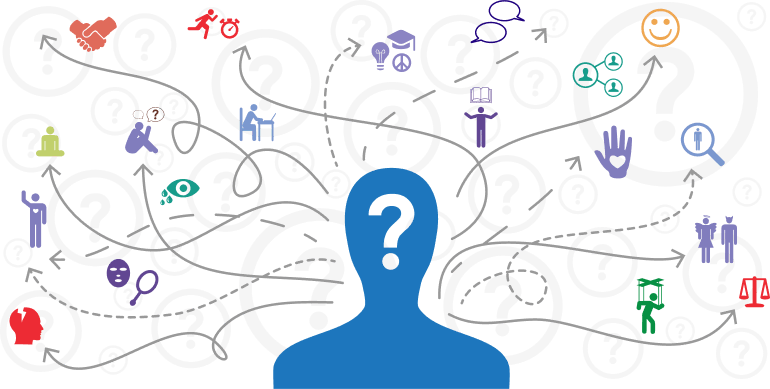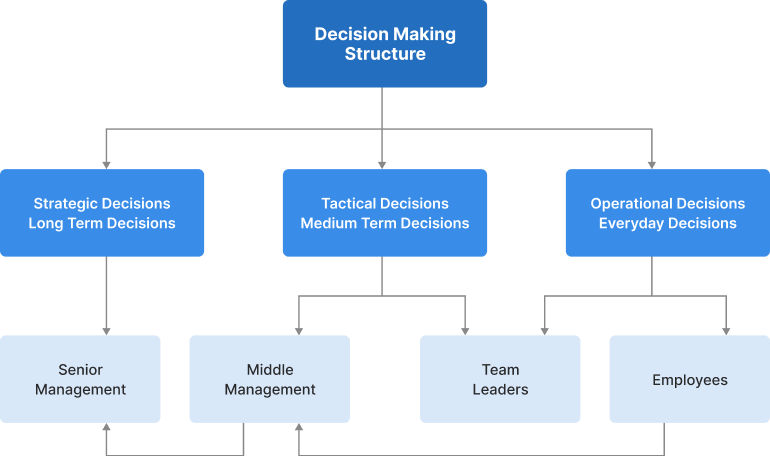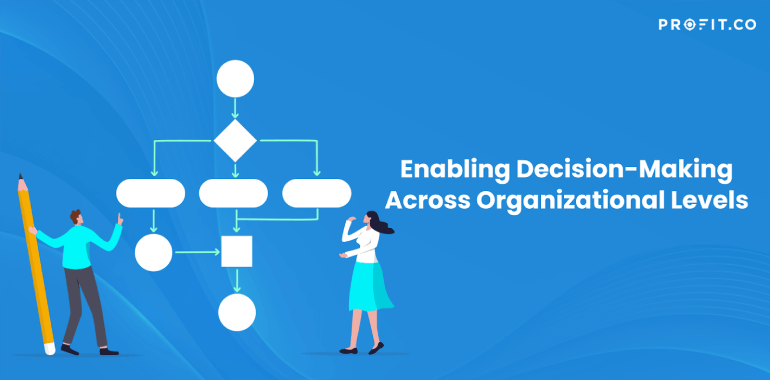In any organization, decisions can alter the company’s course and have a significant and sometimes irreversible impact on the lives of employees, stakeholders, and everyone involved.
Decision-making occurs at different levels, depending on the size of the company. Everyone plays a different role in a small company, so the decision-making process is straightforward. In larger companies, decisions are at different levels, so there has to be a proper design for the decision-making process, which requires enforcement at different levels. When implementing a decision-making system, one must deal with it as a change management process so that the proper design is accepted across the organization.

So how can you empower employees at different levels to make smart decisions? Let’s explore decision-enablement and how decision-making occurs in an organization while sharing invaluable insights into how to enable strategic, tactical, and operational decisions.
What is Decision Enablement, and why is it Important?
The hardest part of every employee’s job is to make decisions and more importantly, to make the right decisions that will positively impact the organization they are part of. Decision enablement is designing and implementing an organization’s decision-making structure to ensure that decisions are made effectively, efficiently, and in line with the company’s objectives.

It seeks to provide organizations with the tools and methods they need for successful decision-making at all levels. Decision enablement enables senior management teams to make strategic decisions while empowering employees at different levels of the organization to make tactical or operational decisions as necessary.
This allows organizations to take advantage of their collective intelligence and experience while reducing risk by ensuring the right people have appropriate decision-making authority.
Types of Decisions
Depending on their nature, some decisions have more significant consequences and require deeper consideration. For instance, habitual decisions are simple, like choosing what to wear to work, so we spend little time on them.

Such decisions are popularly known as programmed decisions because they occur frequently enough to become like an automated response. We call this automatic response for such decisions.
For example, most restaurants handle customer complaints daily, making a routine that becomes part of doing business. Since complaints are routine, addressing them can become a programmed decision.
Restaurants can implement a policy that directs that each time a customer has a valid complaint, they should get a free dessert. This policy becomes the decision rule in this case.
In contrast, crucial and unique decisions require careful consideration of available alternatives, collecting information, and conscious thinking. We call such decisions non-programmed decisions. A great example is how McDonald’s Corporation responded to customer complaints about unhealthy levels of calories and fat in their meals.
In 2005, McDonald’s noticed increasing concerns about these unhealthy aspects. For the longest time, customers paid more attention to the food’s price and taste but not how it affected their health. McDonald’s made a non-programmed decision to avail healthier alternatives like substituting french fries with apple slices in Happy Meals and banning trans-fat in their restaurants.
Who Makes the Different Kinds of Decisions in Your Organization?
Strategic decisions occur at the C-level or top management level and can determine or alter the course of a company.
Tactical decisions typically come from mid-level managers and directors, while operational decisions involve lower-level managers and individual contributors in their day-to-day activities.
whenever you see a successful business someone once made a courageous decision
Example 1: Starbucks
Let’s look at one famous example of Starbucks, the coffee company. In such an organization, strategic decisions cut across different functions, including sourcing, type of products, supplier strategic relationships, ESG compliance, etc. The decisions on this level must align with the company’s goals, vision, and mission.
Tactical decisions in Starbucks focus on changing operating hours, which organizational structures to use, reallocating resources to underperforming stores, the number of stores that form a district, and opening and closing some branches.
Operational decisions occur at the store level and affect daily operations. For instance, if a customer complains about bad coffee, Starbucks can decide to replace it for free. This operational decision follows a policy implemented at the top level, but the actual decision comes from the person serving the food or coffee.
Example 2: A software company
Let’s look at a different example in the tech industry that involves a software company. Suppose it’s a startup with one product. In such a case, the product decisions are clear, but there may be other decisions at the strategic level, such as what features to add and who’s responsible for building what feature.
At the tactical level, the decisions may involve hiring the right QA engineers and other talents to work on the product. Operational decisions on a day-to-day basis can be how to allocate work to different teams, which tasks to allocate to particular teams, whether to have special teams for UI and APIs and to define the boundaries.
When running a company, having a clearly-defined decision-making structure is crucial. If we look at another aspect like customer support or success, for example, if a customer calls with an issue, how do you address it? What kind of decisions should you make at what level?
Will you respond like a customer support analyst and inform the customer you’ll guide them through the issue, or does it require further investigation by the next level team first for a more precise response? What’s the process of making these micro-decisions?
Like in the Starbucks example, decisions need a proper design and guidelines from the top. The barista’s decision to replace the coffee does not come from them individually, but rather, it follows a customer-first philosophy that comes from the top. A strategic level decision ensures that the baristas are trained to make these micro-level decisions.
Designing Decision-Making Structures
Designing decision-making structures involves establishing organizational roles and responsibilities to ensure that the decisions made are effective, efficient, and timely.
This includes outlining who is responsible for making which types of decisions and determining how much authority each person or team has when making a decision. It is essential to clearly define what kind of decisions can occur at different levels, such as strategic versus tactical or operational ones.
The question is, do your team members have the proper training to adopt the decision-making framework and make decisions? Will anchoring bias influence them? Instructing someone to handle something a certain way and do it repeatedly with others is not enough.
Your team requires training on handling different scenarios, so it’s best to enact various situations. This way, when you leave the team to work, the micro decision-making will be simple and nearly effortless.
You must also establish systems for allocating decision-making authority among teams and individuals. This should include how far down the organizational hierarchy a particular person’s input will go before they have complete control over making the final call on a given issue.

For example, senior management has to make executive decisions without involving lower-level employees. Establishing this structure helps keep everyone accountable for their roles in decision-making processes.
Decisions made using proper data, through the right process tend to be usually good. Thus, a prerequisite for good decisions is to implement technology support systems throughout your organization’s operations so that data analysis capabilities can assist with information and better decisions across all levels of leadership. These tools give managers access to real-time information about various aspects of the business, including customer trends, financial performance metrics, production output data points, etc.
This data allows them to make more informed choices quickly and efficiently while ensuring alignment with broader corporate objectives. By utilizing these technologies alongside traditional methods of gathering insights like stakeholder interviews and surveys, you can gain greater insight into internal operations and external market conditions for better agility.
Ready for data driven decision making?
Decision Analysis
It is crucial to analyze the outcome of decisions and iterate processes for future purposes to ensure effective decision-making within an organization. This allows you to identify areas like the influence of bounded rationality in decision-making. This analysis enables you to improve the current state of decision-making processes and develop strategies for preventing similar issues in the future.
You can leverage data analysis techniques to gain valuable insights into how various decisions impact the overall organizational objectives over time. By conducting regular reviews on outcomes, you can better understand what factors influenced successful or unsuccessful results so that you can adjust accordingly.
Analyzing past trends related to particular scenarios also enables managers to anticipate potential risks or opportunities that may arise while allowing them enough time to plan with greater accuracy.

Your organization will be more prepared to face new challenges in the present and future if you continuously iterate your decision-making process based on the findings you uncover through data analysis. Iterative approaches allow your team to learn from their previous successes and failures so they do not repeat the earlier mistakes while gaining a deeper understanding of complex systems at play throughout operations.
Through this approach, your team can avoid decision fatigue and make smart yet informed choices that lead to achieving the desired goals quickly and more efficiently.
Conclusion
Decision enablement is essential to a business’s strategy to ensure that decisions occur most effectively and efficiently.
You can be well-equipped to make smart, data-based decisions by:
- Establishing clear expectations around who should make what types of decisions
- Setting protocols for implementing these guidelines across all levels of management and employees
- Regularly reviewing outcomes with those responsible for making decisions
- Continuously iterating processes based on findings from data analysis activities
Furthermore, involving stakeholders such as customers, suppliers, or partners can add value by providing a unique perspective you may not have considered. Doing so also helps build trust between external parties while allowing them insight into how you consider their opinions when making critical business decisions.
Ultimately, this allows your team to collaborate more effectively toward successful decision-making while ensuring alignment with corporate objectives.

